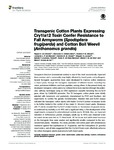Por favor, use este identificador para citar o enlazar este ítem:
http://www.alice.cnptia.embrapa.br/alice/handle/doc/1066050Registro completo de metadatos
| Campo DC | Valor | Lengua/Idioma |
|---|---|---|
| dc.contributor.author | OLIVEIRA, R. S. de | pt_BR |
| dc.contributor.author | OLIVEIRA NETO, O. B. | pt_BR |
| dc.contributor.author | MOURA, H. F. N. | pt_BR |
| dc.contributor.author | MACEDO, L. L. P. de | pt_BR |
| dc.contributor.author | ARRAES, F. B M. | pt_BR |
| dc.contributor.author | LUCENA, W. A. | pt_BR |
| dc.contributor.author | LOURENCO, I. T. | pt_BR |
| dc.contributor.author | BARBOSA, A. de D. | pt_BR |
| dc.contributor.author | SILVA, M. C. M. da | pt_BR |
| dc.contributor.author | SA, M. F. G. de | pt_BR |
| dc.date.accessioned | 2017-03-03T11:11:11Z | pt_BR |
| dc.date.available | 2017-03-03T11:11:11Z | pt_BR |
| dc.date.created | 2017-03-03 | pt_BR |
| dc.date.issued | 2016 | pt_BR |
| dc.identifier.citation | Frontiers in Plant Science, v. 7, Article 165, 2016. | pt_BR |
| dc.identifier.uri | http://www.alice.cnptia.embrapa.br/alice/handle/doc/1066050 | pt_BR |
| dc.description | Gossypium hirsutum (commercial cooton) is one of the most economically important fibers sources and a commodity crop highly affected by insect pests and pathogens. Several transgenic approaches have been developed to improve cotton resistance to insect pests, through the transgenic expression of different factors, including Cry toxins, proteinase inhibitors, and toxic peptides, among others. In the present study, we developed transgenic cotton plants by fertilized floral buds injection (through the pollen-tube pathway technique) using an DNA expression cassette harboring the cry1Ia12 gene, driven by CaMV35S promoter. | pt_BR |
| dc.language.iso | eng | eng |
| dc.rights | openAccess | eng |
| dc.subject | Gosspypium hirsutum | pt_BR |
| dc.subject | Genetic cotton transformation | pt_BR |
| dc.subject | Polen-tube pathway | pt_BR |
| dc.title | Transgenic cotton plants expressing Cry1la12 toxin confer resistance to fall armyworm (Spodoptera frugiperda) and cotton boll weevil (Anthonomus grandis). | pt_BR |
| dc.type | Artigo de periódico | pt_BR |
| dc.date.updated | 2017-03-03T11:11:11Z | pt_BR |
| riaa.ainfo.id | 1066050 | pt_BR |
| riaa.ainfo.lastupdate | 2017-03-03 | pt_BR |
| dc.contributor.institution | RAQUEL S. de OLIVEIRA, CATHOLIC UNIVERSITY OF BRASILIA; OSMUNDO B. OLIVEIRA NETO, CENARGEN; HUDSON F. N. MOURA, CENARGEN; LEONARDO LIMA PEPINO DE MACEDO, Cenargen; FABRÍCIO B. M. ARRAES, CENARGEN; WAGNER ALEXANDRE LUCENA, CNPA; ISABELA TRISTAN LOURENCO TESSUTTI, Cenargen; AULUS A. de DEUS BARBOSA, CENARGEN; MARIA CRISTINA MATTAR DA SILVA, Cenargen; MARIA FATIMA GROSSI DE SA, Cenargen. | pt_BR |
| Aparece en las colecciones: | Artigo em periódico indexado (CNPA)  | |
Ficheros en este ítem:
| Fichero | Descripción | Tamaño | Formato | |
|---|---|---|---|---|
| Transgeniccottonplantsexpressing.pdf | 824.45 kB | Adobe PDF |  Visualizar/Abrir |









